Computer with MSI B85-G43 motherboard and Intel Xeon E3 1226 processor
May 5, 2015
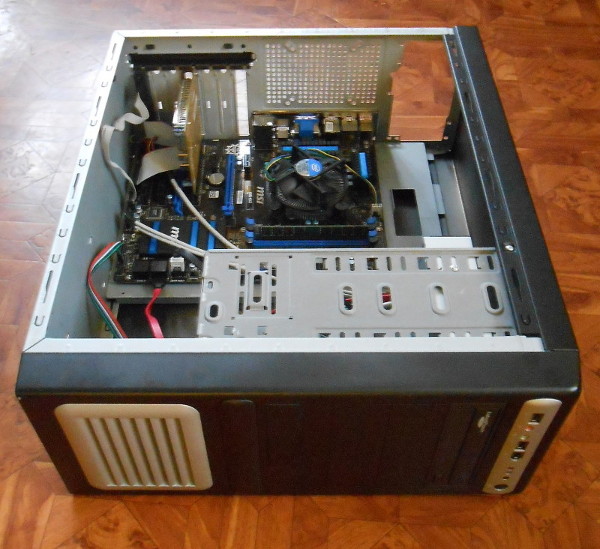
Preparation
In 2013, I was still using my Compal FL90 laptop as my main computer, even though I didn't need mobility.
The laptop still served me well despite dealing with various minor glitches, and the upgrade to 4GB RAM was also beneficial.
But even so, software development was increasingly depressing, thanks to the greater demands of new programs.
Given the need to have a suitable working environment, I therefore decided to get a new computer and also return to the desktop, which is much more suitable for everyday work.
Compared to a laptop, everything is adjustable, so if the workplace is optimised, the health problems that affect people with sedentary jobs are avoided.
That's why I decided to finally build (world wonder) my really first computer.

The first thing to do, however, was to prepare the workstation. So I decided to go ahead with the long-standing plan and use the reprobedny as the base of a large desk.
So I did a partial clear out of the room, removed the small cabinets, moved the cabinets and two imperfect desks.
I used the top from one table as a temporary top for the new table, whose legs are reprobedny.
And I used a saw to smooth one table to a usable state.
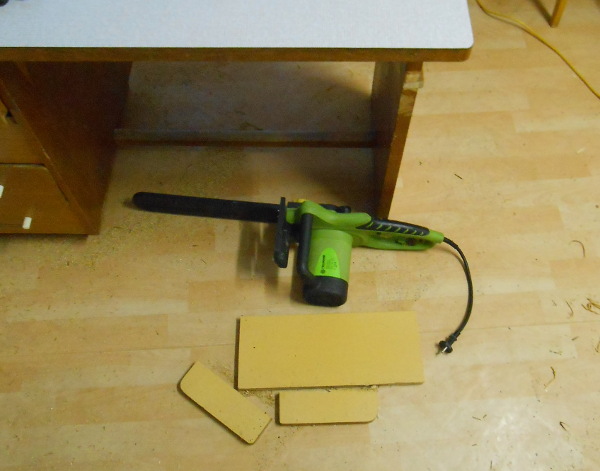
Computer requirements
As always when choosing an important item, I wrote down all the requirements first:- DDR3 (DDR4 was only an expected new feature when Intel launched the X99 platform)
- 4 RAM slots support minimum 32GB better 64GB
- SSD drive - 120GB will be enough, store additional data on the server anyway, TRIM support
- quietly slot for one graphics only, PCI slots min 2x, I don't need PCI-express too much
- serial and parallel port are useful but not a necessity
- DVI output
- IDE/PATA - to be able to connect old disks and especially CD-ROM would be useful
- USB3 - will come in handy in the future
- Graphics - for performance I prefer nVidia chips, which I have good experience with in Linux, but for software development that is not graphics intensive, I'll be fine with an integrated CPU, so either Intel or ATI. Support for at least OpenGL 2. I prefer open drivers.
- CPU - I don't want to be cheated out of some good features. For example, when buying Compalu FL90, I had to make sure that the Intel processor supported virtualization. At least 4 cores (given the integrated GPU, this is the ideal number). Enough cache, at least 4MB, 8MB would be better .
Computer Technology and Component Considerations
So the options were an Intel CPU with an 1150 socket and integrated Intel graphics or an AMD FM2 with integrated ATI graphics or
AMD with a AM3+ socket without integrated graphics.
The Intel socket 1155 chipset has PCI in it, whereas the 1150 does not! And PCI is handled by an extra chip.
The Intel b85 chipset has 4x SATA 6gbps and 2x SATA 3gbps. The h87 and z87 chipsets are all SATA 6gbps.
Those chipsets whose designation ends in 7 have 6x SATA 6gbps. Those ending in 5 have 4x SATA 6gbps + 2x SATA 3gbps).
I don't want the Intel H81 chipset, it only has two RAM slots.
I gave up on IDE/PATA support because the new boards don't include it, so I don't necessarily need IDE/PATA.
With the new board I will have USB3 again, which will definitely be used in the future
nice overview in the Intel processor parameters table
Hardware purchased
I decided to go for a PC based on Intel components in the end, because for normal work I will use higher performance per core rather than better performance in parallelism, in which case I would choose an AMD CPU. But most importantly I decided to choose Intel graphics! The performance of Intel graphics will be enough for me, and with Intel graphics drivers there is usually no problem. On the other hand, if the graphics are not new, the drivers work great in Linux and even better than in Windows.
For example, the MSI MSI B85-G43 motherboard fits the requirements well, as it has a serial and parallel port as well as DVI and 3xPCI in addition to the basic specs.
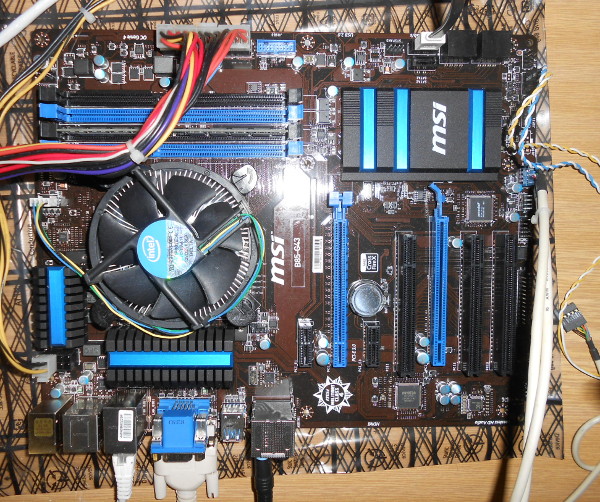
Basic components purchased:
- Intel Xeon E3-1226 v3 - server processor, socket 1150, 3.3GHz, Turbo Boost up to 3.7GHz, 8MB L3 cache, quad core, Haswell, Intel HD P4600 graphics core, TDP 84W,
- Kingston 8GB 1600MHz CL11 - DDR3 RAM, 1600MHz frequency, CL11 timing, 1.5V
- MSI B85-G43 - motherboard, MB, ATX, socket 1150, Intel B85, Haswell, 2x PCIe x16, PCIe x1, 3x PCI, 4x DDR3, 2x SATA 3Gb/s, 4x SATA 6Gb/s, Gb LAN, D-Sub, DVI, HDMI, 6x USB 2.0, 2x USB 3.0, 6x audio jack
- Kingston SSDNow V300 120GB SSD
I have been running the composite computer without a computer case so far:
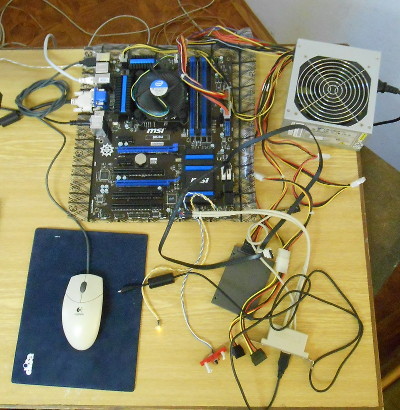
PC case, power supply
The PC case and power supply are also essential components, but these can already be selected without depending on the CPU and motherboard.
I temporarily chose a repaired home power supply.
Later, I bought a regular second-hand PC case including a SATA drive and power supply.
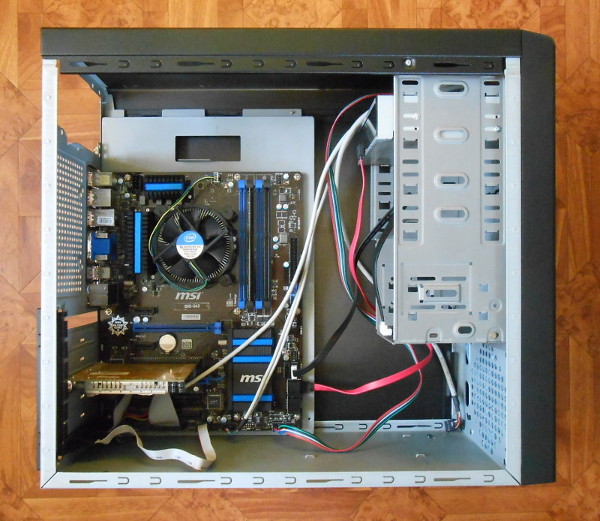
However, I had to adjust the power supply fan on the PSU because it was humming horribly.
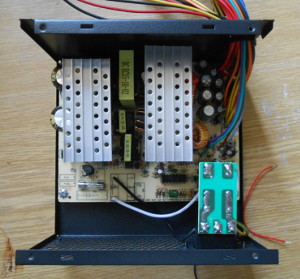
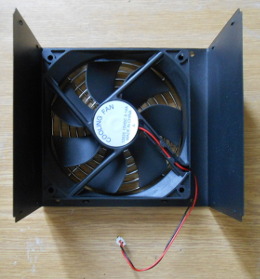
When it comes to a PC case, functionality is the main thing for me, and I require the appearance to be moderate.
It would be good to have a 2x USB3 header, but there aren't many of those on the market....
A 350W power supply is enough for this build.
For long term operation it is also worth investing in a power supply with high efficiency, for example with 80+gold certification.
Once the Banana Pi R1 computer is up and running.
my older excellent Thermaltake Matrix VD2000BNS computer case with 350W 80+ gold certified power supply became available.
And the computer ended up in this case as well.
Accessory Requirements
Monitor, keyboard, mouse, desk, chair are very important accessories, so you need to choose them carefully too!What kind of monitor?
What kind of monitor interface? HDMI vs display port vs DVI? Definitely should have DVI! I wanted a monitor size of at least 21" or more. I was also considering buying two monitors in the future. Since they tend to be more widescreen on the market, I decided to buy one widescreen monitor that would be better for programming than one 4:3 monitor. The size I chose for the widescreen is 24" and 1920 x 1200 (WUXGA) resolution, which is not so insanely widescreen, so the show has a lot of pixels in portrait, and so is suitable for serious work.
Another condition to guarantee good quality was LED technology and a IPS panel. Not NT, which have very low quality colours, as seen in laptops, where to reduce the price they put the cheapest and worst displays.
-
So they came out as candidates in the 24" 1920 x 1200 LED monitor category:
- 24" DELL UltraSharp U2412M - PWM brightness control -> flickers.
- BenQ BL2411PT, 24" IPS - without PWM ->doesn't flicker, can also be positioned and rotated in height, unlike the others it doesn't have a USB HUB.
- AOC i2460Pxqu, also has PWM backlight control.

The winner is the BenQ BL2411PT, which has no PWM backlight and as a bonus, it is also adjustable in 3 axes: height, sideways and can be rotated to portrait.
Another interesting improvement is the user presence sensor, according to which the monitor can switch itself off. The monitor includes integrated speakers, but of course, they fall short of the quality of high-end speakers, and I would have liked a higher maximum reproduction volume.
The monitor's menu controls are touch-sensitive, which surprised me personally for the first time.
Operating
The first thing to do after buying hardware is to upgrade the firmware, in this case the BIOS and possibly the disk firmware.
I have updated the BIOS.
The SSD I purchased had the firmware up to date.
I originally considered moving the existing work computer system, but in the end I decided to install a clean system and copy "only" the user.
However, the problem was the boot of the installer without the DVD drive. I do have a bunch of drives, but only with a PATA interface.
Additionally, I ran into the problem that the network installation of magei 4 64bit didn't get along with the network drive.
Interestingly, the 32bit version did not have the problem.
So I made the system install a bit more complicated, which I described in the article
How to install a system without a DVD drive.
The only major technological difference from the original PC was the use of an SSD. An SSD is different from the original rotating disk, so I had to think about the best use of it. In the article How to use an SSD, what filesystem to choose, and how to use TRIM I summarized everything.
After installing linux it's just a matter of moments to install the necessary programs. Use the following command to get a list of installed packages on the system:
rpm -qa>rpmlist.txtJust sort the created file and remove duplicate lines. For example, simply in the VIM text editor with the command:
:%sort uThen just use
diff to compare the files from both computers and select the programs you want to install.
As a last step, you need to copy the selected system configuration files.
For example for CUPS,Apache etc.
As the very last step, create users and copy the /home directory which contains the user directories with their data.
In this way, you can easily perform an installation optimized for a new computer and while quickly performing an installation that is indistinguishable from the original computer.
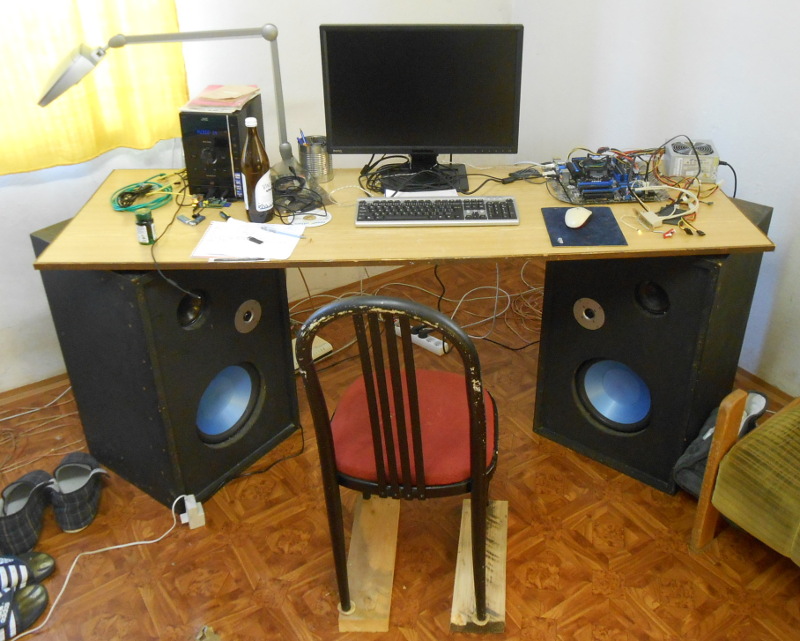
First experiences
Compared to the original older compal FL90 laptop, the following differences are obviously noticeable:
- more performance
- more memory
- faster bus
- faster SSD read speeds
Hardware details
Hardware listing computers with MSI B85-G43 motherboard and Intel Xeon E3 1226 processorHardware listing:
lspci 00:00.0 Host bridge: Intel Corporation Xeon E3-1200 v3 Processor DRAM Controller (rev 06) 00:02.0 VGA compatible controller: Intel Corporation Xeon E3-1200 v3 Processor Integrated Graphics Controller (rev 06) 00:03.0 Audio device: Intel Corporation Xeon E3-1200 v3/4th Gen Core Processor HD Audio Controller (rev 06) 00:14.0 USB controller: Intel Corporation 8 Series/C220 Series Chipset Family USB xHCI (rev 05) 00:16.0 Communication controller: Intel Corporation 8 Series/C220 Series Chipset Family MEI Controller #1 (rev 04) 00:1a.0 USB controller: Intel Corporation 8 Series/C220 Series Chipset Family USB EHCI #2 (rev 05) 00:1b.0 Audio device: Intel Corporation 8 Series/C220 Series Chipset High Definition Audio Controller (rev 05) 00:1c.0 PCI bridge: Intel Corporation 8 Series/C220 Series Chipset Family PCI Express Root Port #1 (rev d5) 00:1c.1 PCI bridge: Intel Corporation 8 Series/C220 Series Chipset Family PCI Express Root Port #2 (rev d5) 00:1c.3 PCI bridge: Intel Corporation 82801 PCI Bridge (rev d5) 00:1d.0 USB controller: Intel Corporation 8 Series/C220 Series Chipset Family USB EHCI #1 (rev 05) 00:1f.0 ISA bridge: Intel Corporation B85 Express LPC Controller (rev 05) 00:1f.2 SATA controller: Intel Corporation 8 Series/C220 Series Chipset Family 6-port SATA Controller 1 [AHCI mode] (rev 05) 00:1f.3 SMBus: Intel Corporation 8 Series/C220 Series Chipset Family SMBus Controller (rev 05) 02:00.0 Ethernet controller: Realtek Semiconductor Co., Ltd. RTL8111/8168/8411 PCI Express Gigabit Ethernet Controller (rev 06) 03:00.0 PCI bridge: ASMedia Technology Inc. ASM1083/1085 PCIe to PCI Bridge (rev 03)
Boot
UEFI Mageia can boot from a CD using UEFI, but to boot an installed system, you need to manually enable and install UEFI boot and use the UEFI boot loader. But so far, it looks like UEFI doesn't bring any major benefits and the main reason why UEFI is being pushed into the market is secureboot, which often can't be turned off, so UEFI along with secureboot is a way to force a pre-installed MS Windows system on users.
SSD drive
Disk performance test. You can see that the performance is completely different compared to rotating disks.
# hdparm -Tt /dev/sda /dev/sda: Timing cached reads: 29038 MB in 2.00 seconds = 14534.89 MB/sec Timing buffered disk reads: 1108 MB in 3.01 seconds = 368.68 MB/sec
CPU
Listing of processor information. It has four cores, so the information in the listing is repeated four times:cat /proc/cpuinfo processor : 3 vendor_id : GenuineIntel cpu family : 6 model : 60 model name : Intel(R) Xeon(R) CPU E3-1226 v3 @ 3.30GHz stepping : 3 microcode : 0x19 cpu MHz : 3692.906 cache size : 8192 KB physical id : 0 siblings : 4 core id : 3 cpu cores : 4 apicid : 6 initial apicid : 6 fpu : yes fpu_exception : yes cpuid level : 13 wp : yes flags : fpu vme de pse tsc msr pae mce cx8 apic sep mtrr pge mca cmov pat pse36 clflush dts acpi mmx fxsr sse sse2 ss ht tm pbe syscall nx pdpe1gb rdtscp lm constant_tsc arch_perfmon pebs bts rep_good nopl xtopology nonstop_tsc aperfmperf eagerfpu pni pclmulqdq dtes64 monitor ds_cpl vmx smx est tm2 ssse3 fma cx16 xtpr pdcm pcid sse4_1 sse4_2 x2apic movbe popcnt tsc_deadline_timer aes xsave avx f16c rdrand lahf_lm abm ida arat xsaveopt pln pts dtherm tpr_shadow vnmi flexpriority ept vpid fsgsbase tsc_adjust bmi1 hle avx2 smep bmi2 erms invpcid rtm bogomips : 6599.80 clflush size : 64 cache_alignment : 64 address sizes : 39 bits physical, 48 bits virtual power management:
Computer workstation
Currently my workstation is set up as follows:
I have a desk top via reprobedny, but I have it as a workbench.
I chose the original desk as my computer desk, which I modified with a saw.
And I still use it because as a computer desk, its height is appropriate.
I plan to make more big changes in the future, but for now I have reached the basic standard of workplace quality.
That is, enough dedicated space, which is needed not only for my computer activities.
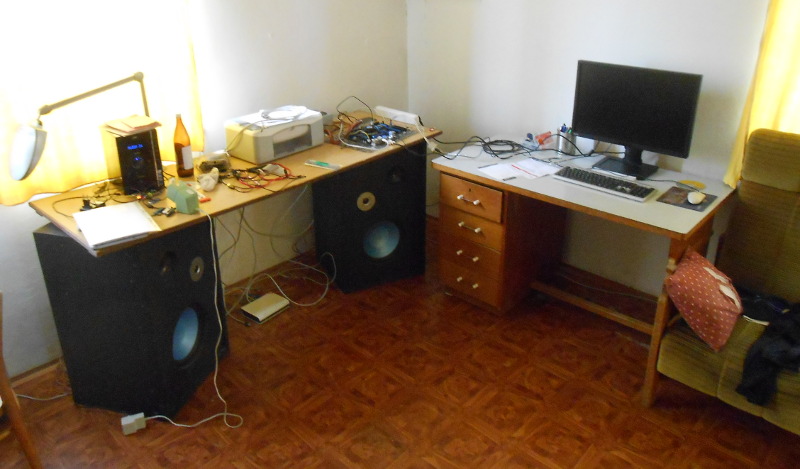
Long-term experience
So far, I rate the hardware of the computer as trouble-free in terms of commissioning and operation.
Articles on a similar topic
Lenovo Thinkpad P14s battery life and UEFI/BIOS flashing
Industrial computer IPO ODYSSEE 18WT
Which mouse to choose for my computer?
Samsung S24H850 monitor
TUXEDO Pulse 15 - Gen2
How to connect a computer to a mobile phone running Android
Data backup
Banana Pi R1 case
Single board ARM computer Banana PI R1
How to use an SSD and TRIM
Using TouchBook in practice
Compal FL90 and GNU/Linux
Disassembled computer disk
Newsletter
If you are interested in receiving occasional news by email.
You can register by filling in your email
news subscription.
+





